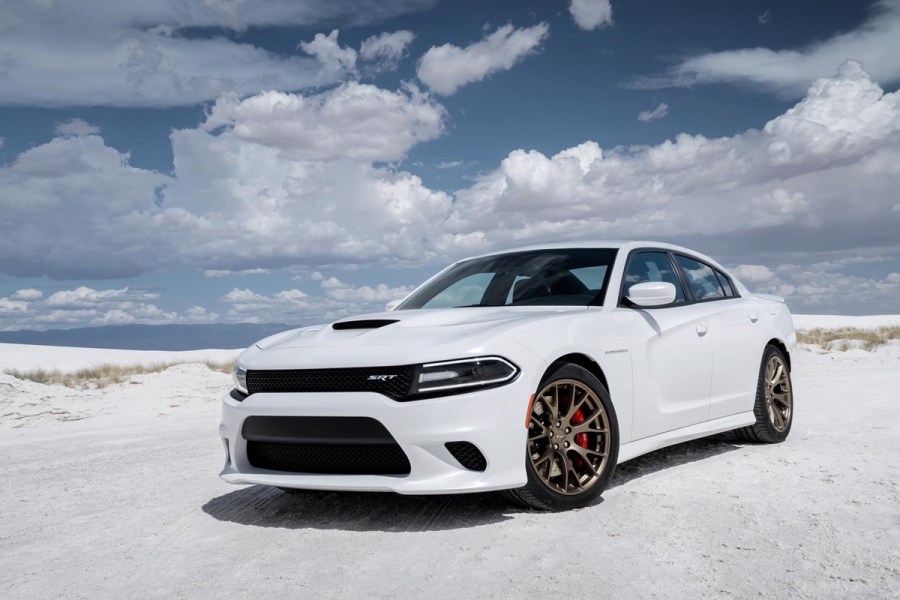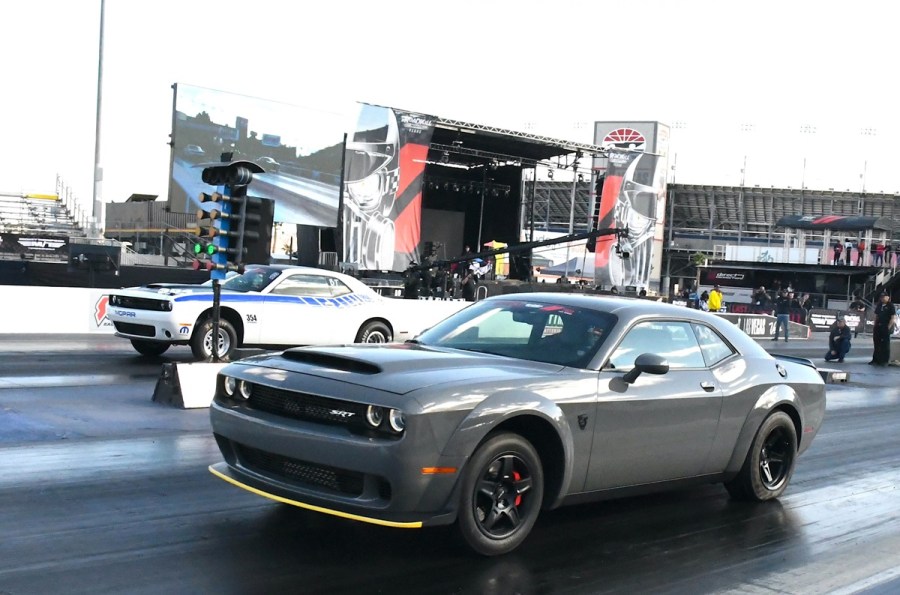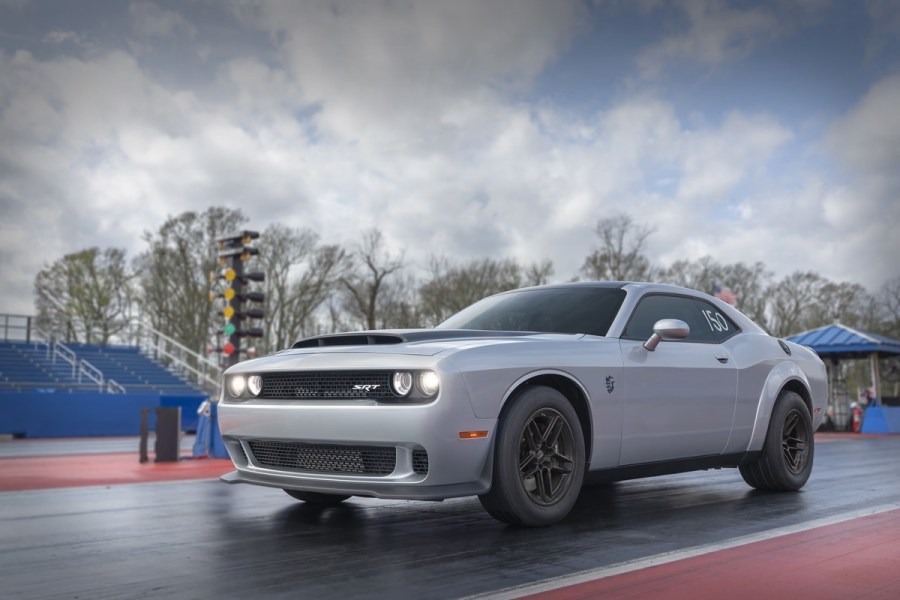Production of these Detroit beasts is coming to an end, meaning if you want one, you’ll have to turn to the used market. So, here’s our Dodge Hellcat buyer’s guide.
It’s safe to say that Dodge changed everything in the muscle car world in 2015 with the launch of the Challenger and Charger SRT Hellcat. The Charger had been for sale since late 2005 as a 2006 model, and the reimagined Challenger came on the scene in 2008. The Charger was redesigned as a four-door sport sedan, while the Challenger held to its past as a two-door sport coupe.
From the beginning the Charger and Challenger alike were intended to reignite the Pony Wars of the late 1960s, when the big three American automakers competed to see who could produce the best performance car among the Challenger, Ford Mustang, Chevrolet Camaro, and Pontiac Firebird. In that era, the Charger was more of a traditional muscle car. When the sixth-generation Charger and third-generation Challenger arrived, Dodge threw down the gauntlet in both the pony car and muscle car categories.
The engine range featured, naturally, a selection of Hemi engines. In this design, the combustion chamber is domed into a hemisphere. This allows the spark plug to be placed near the center of the chamber, with the intake and exhaust valves on either side. The increased interior surface area of the domed design allows for larger valves and thus improved high rpm power. Dodge offered the Charger and Challenger with a 5.7-liter or 6.1-liter and later 6.4-liter Hemi engine options. The 6.4-liter Hemi produced as much as 485 horsepower through the 2023 model year. This guide will talk through all those evolutions, and many more besides, as well as touching upon some of the problem areas for you to be aware of.

Common Problems in brief
- engine oil cooler hose fault in 2017 models
- faulty cruise control in 2018 Demons
- general abuse from previous owners – check for all the usual signs of wear and tear

The first Hellcat supercharges the Hemi
What made the Hemi into its most potent form was the addition of a twin-screw IHI supercharger capable of delivering 11.6 psi of boost. The Hellcat engine is based on the naturally aspirated 6.4-liter Hemi, but uses the shorter stroke of the 5.7-liter Hemi to produce a 6.2-liter displacement. The maximum rating of the Hellcat V8 was 707 horsepower and 650 lb-ft of torque, passed to the rear wheels through an 8-speed TorqueFlite automatic transmission or an optional 6-speed manual in the Challenger. Dodge delivered each Hellcat with two key fobs, color-coded red and black. When used, the red key fob enabled the full 707 horsepower output, while the black fob limited the Hellcat to 500 horsepower.
When the Hellcat hit the market, the Charger became the fastest four-door sedan ever offered for sale to the public. The Challenger would do a 0-60 dash in 3.5 seconds and cover a quarter-mile in about 11.5 seconds. The Charger was only slightly slower, making 0-60 in 5 seconds and the quarter-mile in 12 seconds. But these cars were more than fast in a straight line, they can pull 0.94g to 0.96g on the skidpad. Braking was also improved with six-piston front Brembo calipers over two-piece 15.4-inch slotted rotors and four-piston rear Brembo calipers.
Finally, the top speed for both cars is about 203 mph so a buyer could theoretically buy a Hellcat, drive it to Bonneville speed week, and take home a 200 MPH Club cap for their trouble.

Prices & what to look for
Priced in the low $60,000 range, the Hellcats became the most affordable pair of supercars on the market. Current prices for a used Hellcat with low miles and excellent condition range from about $40,000 to $50,000.
Special editions of the Challenger Hellcat started almost immediately. In 2016, there was a 750-horsepower dealer special edition limited to Texas that was lowered and came with an upgraded supercharger and a paint-and-stickers package. It’s unknown exactly how many of these Texas dealer cars were made.
2017 Challenger Hellcat models were subject to a recall for a problem with engine oil cooler hoses, which could fail, spraying oil around the engine bay or the windshield, creating a risk of fire as well as of sliding on the oil. Dodge replaced the faulty hoses on all affected vehicles.
Overall, Hellcats have an excellent reliability record, with a J.D. Power rating of 85 out of 100 for quality and 88 of 100 for reliability.

2018 Challenger Hellcat Demon
In 2018, Dodge brought out the Challenger Hellcat Demon, which tuned the 6.2-liter supercharged Hemi engine to 808 horsepower on 91 octane premium pump gas, or up to 840 horsepower on 100 octane racing fuel. Torque is 770 lb-ft on racing gas.
The Demon was designed as a dedicated drag racing car, with only a driver’s seat installed. However, the Demon was street legal, if only barely. The stock tires are designed for drag racing, with just enough tread to be driven on public roads legally. The missing passenger and rear seats and a few other items saved over 200 pounds compared to a standard Challenger. Additionally, the Demon came with a unique transmission brake, which puts the transmission into first and second gear at a stop, allowing the engine to spin up torque before the driver releases the car for launch.
Performance was impressive with a 2.3-second 0-60 time and a 9.65-second ET in the quarter-mile. With 14.5 psi of boost, the Demon could generate 1.8g acceleration using launch control, which is enough to lift the front wheels completely off the ground. However, the Demon was limited to 168 mph top speed. Dodge delivered the Demon with the same red key/black key combination, with the black key still limiting power output to 500 horsepower.

Prices & what to look out for
Dodge made only 3,300 Challenger Hellcat Demons, with 3,000 offered in the United States and 300 in Canada. The entire production run was pre-sold to select customers. The 2018 Demon’s retail price was $84,995, but if you want one now be prepared to spend up to $150,000 on the auction market.
The Demon and the Demon Crate Engine were subject to a recall shortly after its launch in 2018. The recall replaced or updated the powertrain control module on the Mopar Stage 1 Kit Performance Package. The defect could prevent the cruise control system from disengaging when the driver stepped on the brake pedal or when the driver turned the system. The defect could cause the Demon to maintain speed or even accelerate. When buying a Demon or Demon crate engine, it’s smart to be certain that recall has been completed.

2019 Challenger SRT Hellcat Redeye & Charger SRT Hellcat
For the 2019 model year, the base Challenger Hellcat engine raised its output to 717 horsepower, keeping torque at 650 lb-ft. The reason for the changes was the new Challenger SRT Hellcat Redeye, which was a slightly detuned Demon engine rated at 797 horsepower and 707 lb-ft of torque. The Redeye models also upgraded the 8-speed automatic transmission, suspension, axles, and cooling system to handle the additional power. The Challenger Redeye carried a sticker price of $83,250, compared to $61,745 for the basic Challenger Hellcat.
For the Charger SRT Hellcat, the base 707 horsepower engine remained unchanged, but the Charger gained a list of improvements including Launch Assist, which uses wheel speed sensors to watch for driveline-damaging wheel hop at launch and, in milliseconds, modifies the engine torque to regain full grip. The engineers also added Line Lock, which engages the front brakes to hold the car stationary, but leaves the rear wheels free for a burnout to heat up and clean the rear tires. As another performance enhancer, the 2019 Charger includes Torque Reserve, which closes a bypass valve to prefill the supercharger and manages fuel flow and spark advance to balance engine rpm and torque. This action generates a reserve of torque that is delivered upon acceleration from a standing stop.
Finally, to improve longevity the 2019 models also received an After-Run Chiller, which keeps cooling the supercharger/charge air cooler after the engine is shut off.

Styling Alterations
Another advancement that came along in 2019 is the Challenger Widebody Package. This package delivered wider fender flares at all four corners, but there’s more to it than that. Buyers also got new 20×11-inch Devils Rim forged aluminum wheels wrapped in 305/35ZR20 tires, a three-mode Bilstein adaptive damping suspension uniquely tuned for competition use. The Charger Hellcat got the Widebody option a year later for the 2020 model year.

2021 Challenger SRT Hellcat Redeye Super Stock & Charger Hellcat Redeye
Dodge won’t let much time go by without a special edition, and 2021 saw the delivery of the Challenger Hellcat Super Stock, with 807 horsepower, lightweight wheels, racing tires, and a suspension optimized specifically for drag racing. This model could complete a pass in 10.5 seconds. The Super Stock retailed for $83,190, while the price of the base Challenger Hellcat dropped to $58,995.

For the Charger, 2021 brought the Redeye engine and performance package to the four-door offering. The Charger Redeye included the Widebody package, or you could get the Widebody with 717 horsepower without the Redeye engine.
Note that the Tremec 6-speed manual transmission was removed as an option for some length of time in 2021 and 2022, but returned for the 2023 model year as the standard gearbox for the Challenger. The 6-speed was never offered on the Charger.

2022-2023 Hellcats – Jailbreaks, Widebodies, and the Demon 170
At the start of the 2022 model year, Dodge announced the end of the Challenger and Charger Hellcats as they have been known, hinting that a replacement powerhouse would perhaps be electrified. However, the Hellcat line will go out with a roar and the squeal of outraged rubber.
To facilitate a big ending, Dodge announced the “Jailbreak” editions in 2022. The Jailbreak edition Challenger and Charger are based on the Hellcat Redeye Widebody with 807 horsepower. Jailbreak editions are extensively customizable, with different color interiors, badging, and infotainment. On the exterior, buyers can choose stripes, paint colors, brakes calipers, wheels, badging, exhaust tips, and aero features. Jailbreak editions will continue through the end of production.

As a final hurrah, Dodge released the Challenger SRT Demon 170. This car is rated at 1,025 horsepower and 945 lb-ft of torque. Priced at $96,666, Dodge will build just 3,000 for American buyers and 300 for Canadians. At the moment, the Demon 170 is the quickest production car in the world, achieving 60 MPH in just 1.66 seconds. The Demon 170’s ET is just 8.91 seconds, if you can get the NHRA to let you drive it on the strip.
If you wanted one, you would have had to find a dealer willing to sell you their allocation back in the Spring. The last one off the assembly line sold at auction for $700,000, with proceeds going to charity. We don’t know what the aftermarket price will be for “ordinary” Demon 170 cars because they haven’t arrived at auctions yet, but it’s safe to say prices will stay high for years.

Buying a Hellcat – How much should I pay?
One piece of good news for buyers of Hellcats is that Dodge made so many of them that they will never be rare. Some automakers produce just a handful of high-power vehicles to achieve a halo effect. Dodge went the other way, cranking out as many Hellcats as possible for 9 years, and dropping the price along the way. For the aspiring buyer, that means you can take your pick of quality examples and let the sellers compete for your dollar.
This doesn’t mean any Hellcat will be cheap, exactly, but you can expect to spend $40,000 to $50,000 for a basic Hellcat, and then more for special models like Redeyes and Widebodies. The 2018 Demon is widely available through online auctions, with most prices topping $100,000 and often reaching $150,000. Super Stock models are around $100,000, and modern Jailbreak Redeye editions about the same price.
As always, condition and mileage are the main factors you want to look for in a pre-owned muscle car. Higher mileage examples will be sold through dealers, while only the most special and low-miles examples will find their way to premium online auction sites. However, dealer examples may be priced competitively with auction prices, so do check the entire market before buying a second-class car at a first-class price.
With just a few minor recalls and issues, the Charger and Challenger Hellcat series are among the most reliable and cost-effective high performance cars available on the market at any price. Buying a Hellcat is a smart idea if you’re looking for a car you can drive today and keep as a collectible tomorrow.
Dodge SRT Hellcat Timeline
2015: Challenger SRT Hellcat and Charger SRT Hellcat debut with 707 horsepower
2018: Challenger Demon is offered with 840 horsepower
2019: Challenger Redeye at 797 horsepower and Widebody packages added
2021: Challenger Super Stock at 807 horsepower, Charger Widebody at 717 horsepower, Charger Redeye Widebody at 797 horsepower
2022: Customizable Jailbreak editions at 807 horsepower
2023: Challenger Demon 170 at 1,025 horsepower




